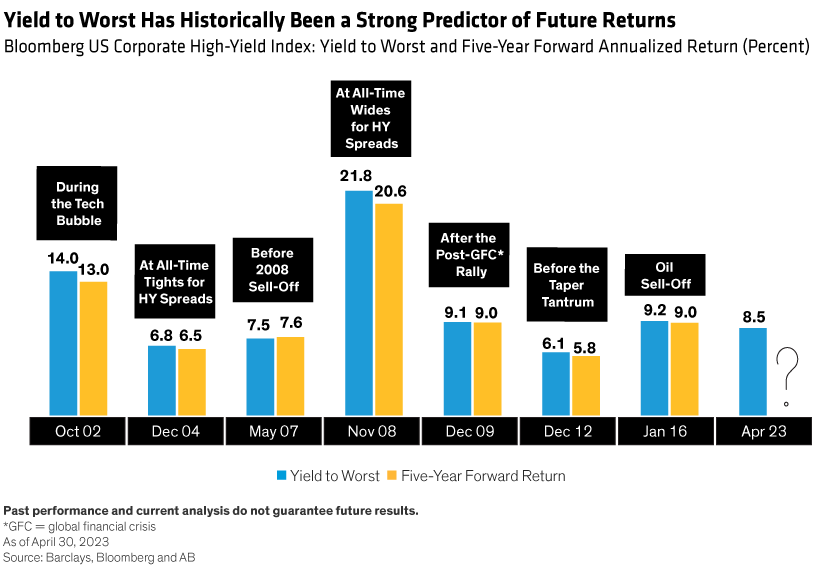Investors Can Help Boost Income and Liquidity with Active High-Yield ETFs
5 min read
Strong Fundamentals Late in the Cycle
At the brink of most slowdowns, corporate fundamentals are already weak. But today’s high-yield bond issuers are in much better shape financially than issuers entering past slowdowns, thanks in part to an extended period of uncertainty surrounding the coronavirus pandemic.
This uncertainty led companies to manage their balance sheets conservatively over the past few years, even as profitability recovered. As a result, leverage and coverage ratios, margins, and free cash flow (what is left after a business pays its day-to-day operating expenses) improved—and corporate issuers can now withstand more pressure as growth and demand slow. Further, the default cycle triggered by the pandemic—with defaults peaking at 6.3% in October 2020—effectively cleaned up the sector. The weakest companies defaulted and are now no longer part of the investable universe. Since then, we believe there simply hasn’t been enough time for the survivors to develop unhealthy financial habits.
We believe the pandemic-led wave of defaults and downgrades also strengthened the average quality of the high-yield market, as many of the lowest-rated bonds defaulted and fell out of indices, while formerly investment-grade bonds fell into the high-yield market as fallen angels. Consequently, the quality of today’s high-yield market is unusually high, with BB-rated bonds comprising 49% of the market, versus 43% on average over the past 20 years.
High Yield That’s Truly High
And today’s yields are compelling too. Yields on high-yield corporate bonds are higher recently than they’ve been in years, giving income-seeking investors a long-awaited opportunity to fill their tanks. What’s more, history shows that the US high-yield sector’s yield has been an excellent proxy for its return over the following five years. In fact, US high yield has performed predictably, even through rough markets (Display).

Indeed, high-yield bonds supply an income stream that few other assets can match. That’s why, even in the late stages of the credit cycle, we think high-yield bonds should play a role in the portfolios of income-seeking investors.
Easier Access, Enhanced Liquidity with Active ETFs
While trading costs can be larger in the high-yield market than in more broadly traded markets, major market disruptions over the past 15 years—the global financial crisis, the taper tantrum of 2013 and the onset of the COVID-19 pandemic—illustrate the liquidity advantage of an ETF overlay. In those episodes, when liquidity dried up in the high-yield market, the higher trading volume of ETFs worked as a type of relief valve for liquidity.
Actively managed ETFs have exploded in popularity1 since 2020, thanks to the ETF wrappers’ liquidity, transparency and tax efficiency, combined with the benefits of active management at a lower cost. In April 2023, AllianceBernstein successfully completed its first mutual-fund-to-ETF conversion. The AB High Yield ETF (ticker: HYFI) is an actively managed ETF that seeks to provide high income and maximize capital appreciation through a combination of security-level fundamental and quantitative analysis. HYFI gives investors access to AB’s acclaimed high-yield bond investment strategy, with a decade-long track record, at a low cost.
Find out more about AB High Yield ETF and AB’s actively managed ETFs here.
1 Funds Europe.com, Active ETFs see heightened inflows, May 30, 2023
Yield to worst is a measure of the lowest possible yield that can be received on a bond with an early retirement provision.
As of January 31, 2023, HYFI’s expense ratio was 0.40%.
Sign Up
AB ETFs. On Active Duty.
Get periodic insights, tools and access to events from AB’s ETF experts.
Thank You
Thank you for contacting us. Expect a reply soon.
Risks To Consider
Investing in ETFs involves risk and there is no guarantee of principal.
Investors should consider the investment objectives, risks, charges and expenses of the Fund/Portfolio carefully before investing. For copies of our prospectus or summary prospectus, which contain this and other information, visit our Literature Center or contact your AB representative. Please read the prospectus and/or summary prospectus carefully before investing.
Shares of the ETF may be bought or sold throughout the day at their market price on the exchange on which they are listed. The market price of an ETF's shares may be at, above or below the ETF’s net asset value ("NAV") and will fluctuate with changes in the NAV as well as supply and demand in the market for the shares. Shares of the ETF may only be redeemed directly with the ETF at NAV by Authorized Participants, in very large creation units. There can be no guarantee that an active trading market for the Fund’s shares will develop or be maintained, or that their listing will continue or remain unchanged. Buying or selling the Fund’s shares on an exchange may require the payment of brokerage commissions and frequent trading may incur brokerage costs that detract significantly from investment returns.
Below Investment Grade Securities Risk: Investments in fixed-income securities with lower ratings (a/k/a junk bonds) are subject to a higher probability that an issuer will default or fail to meet its payment obligations. These securities may be subject to greater price volatility due to such factors as specific municipal or corporate developments and negative performance of the junk bond market generally and may be more difficult to trade than other types of securities.
Credit Risk: A bond's credit rating reflects the issuer's ability to make timely payments of interest or principal - the lower the rating, the higher the risk of default. If the issuer's financial strength deteriorates, the issuer's rating may be lowered and the bond's value may decline.
Derivatives Risk: Derivatives may be more sensitive to changes in market conditions and may amplify risks.
Foreign (Non-US) Risk: Non-US securities may be more volatile because of political, regulatory, market and economic uncertainties associated with such securities. Fluctuations in currency exchange rates may negatively affect the value of the investment or reduce returns. These risks are magnified in emerging or developing markets.
Inflation Risk: Prices for goods and services tend to rise over time, which may erode the purchasing power of investments.
Investment Securities Risk: To the extent the Fund invests in other funds, shareholders will bear to layers of asset-based expenses, which could reduce returns.
Leverage Risk: Trying to enhance investment returns by borrowing money or using other leverage tools magnify both gains and losses, resulting in greater volatility.
Market Risk: The market values of the portfolio’s holdings rise and fall from day to day, so investments may lose value.
AllianceBernstein L.P. (AB) is the investment Adviser for the Fund.
Distributed by Foreside Fund Services, LLC. Foreside is not affiliated with AllianceBernstein.